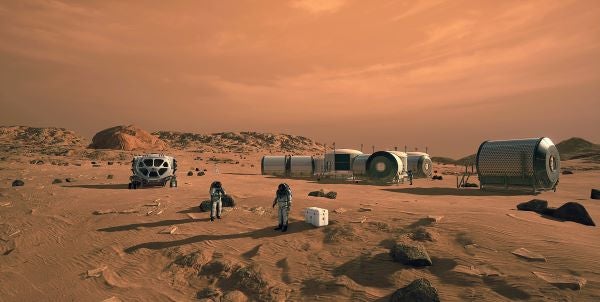Were Schiaparelli’s canali natural rivers bordered by areas of lush vegetation? Or perhaps artificial waterways constructed by an advanced civilization to transfer water from the melting polar caps to the martian deserts? As late as the mid-1900s, the debate still raged over whether Mars was the abode of high-level life forms. The invasion of Earth by beings from Mars has long been a popular science fiction theme, epitomized in H.G. Wells’ 1897 novel War of the Worlds; the tale was famously dramatized in a 1938 radio broadcast by Orson Welles, and later made into films in 1953 and 2005, as well as an ongoing television series.
In 1965, NASA’s Mariner 4 flyby of Mars sent back images of a cratered world that looked more like the Moon than Earth. The subsequent fleet of flybys, orbiters, and landers have shown that there are no canals, no plant life, and no martians. These unmanned missions did, however, reveal that there was a time several billion years ago when Mars was a “living” planet with flowing liquid water — the remains of which now lie frozen beneath the surface. Many researchers believe that microbial life likely could have evolved on this ancient world, and some even think it might still be eking out an existence in Mars’ inhospitable environment.
Today, our fascination with Mars is greater than ever, as plans for human exploration receive revived support. Men and women may be walking on the martian surface in just a few decades — even sooner if Elon Musk’s plans to send SpaceX to Mars become a reality. Fortunately, observers don’t have to wait that long to get a good look at the Red Planet.
Mars takes center stage this month, with a favorable opposition occurring on October 13. It will be the last decent one until 2033, so you’ll absolutely want to make good use of it. Viewing an opposition is straightforward; just wait until Mars is as high above the horizon as possible before attempting to spot it with your telescope. This month, that’s an hour or so before and after midnight, when Mars reaches its zenith position in the southern sky. Work with the highest magnification your telescope can handle (about 50x per inch of aperture under steady seeing conditions). Be patient and wait for those precious fleeting moments when air turbulence settles, and the martian disc appears sharp and crisp.
This time around, though, I want you to view Mars as much with your mind as with your eye. Look at it with the mindset of astronomers a century ago. Forget everything Mariner, the Viking landers, and the Mars orbiters and rovers taught us. Instead, imagine Mars is the desert world inhabited by both the red and green swashbuckling martians described in Edgar Rice Burroughs 1912 pulp novel A Princess of Mars. Think about what it must have been like to view the mysterious Red Planet while isolated in your observatory or backyard, wondering what sort of beings were constructing its canals. It must have been an eerie feeling to look at distant world and wonder if someone was looking back.
And don’t end the martian mind games there! On another evening, imagine how the planet will appear to someone viewing it a century from now. It’ll look almost the same as it does today — visually, at least. But it will still seem different. There might be martians there by that point, but they’ll be humans who have begun colonizing the planet. If you’re old enough to remember the Apollo missions, you’ll recall how your view of the Moon forever changed when it first clicked that humans were actually walking on its surface.
Think of these things as you gaze at Mars this month, because one of those future martians might just end up being one of your descendants. And if you’re young enough, perhaps it could be you.
Questions, comments, or suggestions? Email me at gchaple@hotmail.com. Next month: We explore asteroid 471 Papagena. Clear skies!










